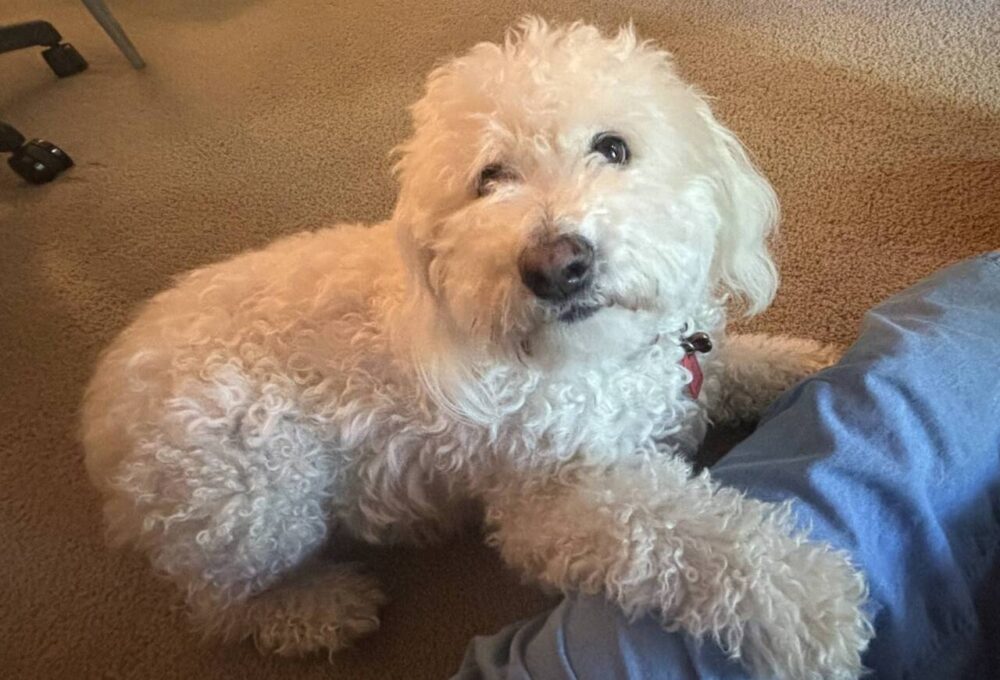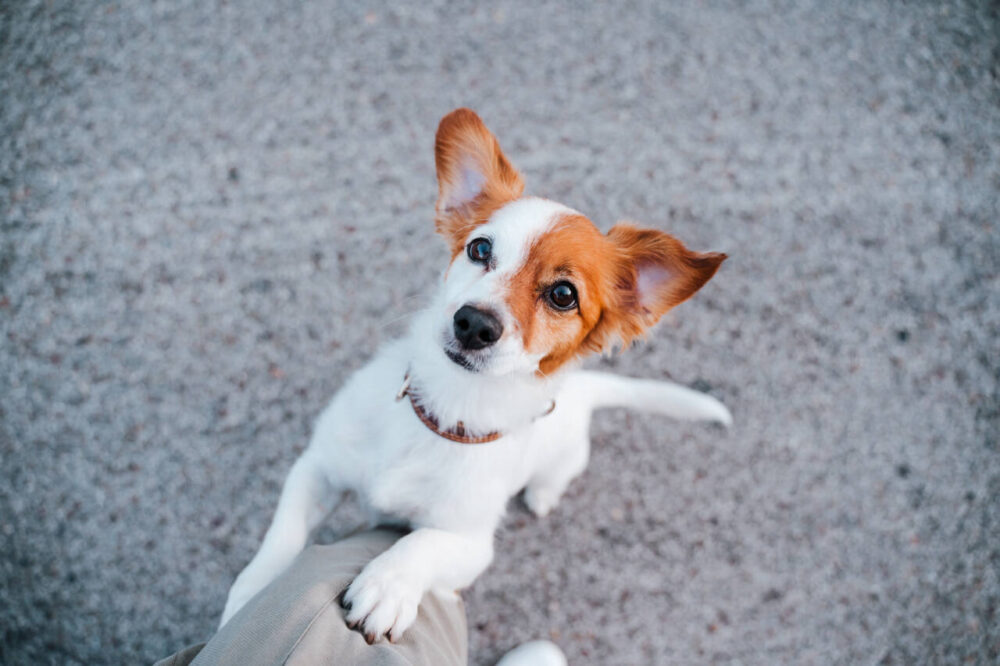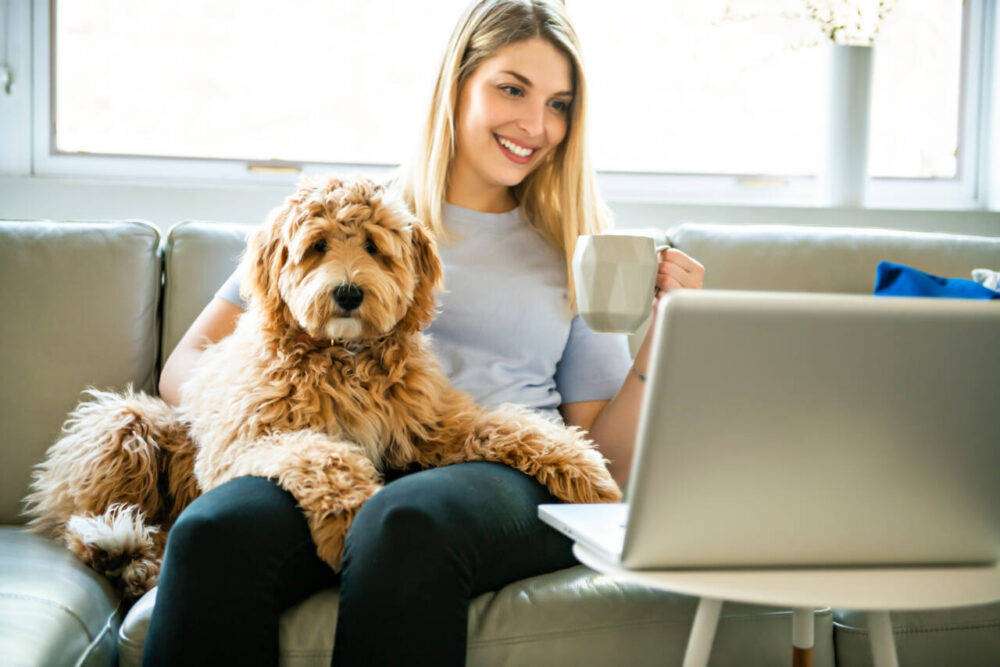I have a dog named Jake who never leaves my side. Since I spend most of my workday sitting in front of my computer, he spends his day lying on the floor next to my Aeron chair, sleeping or gazing up at his queen.
But he much prefers the moments when I sit on the couch or the floor. When that happens, he’s as predictable as the sunrise. He plops down next to me and puts his paw on my leg, every time. See the photographic proof below:

And he’s certainly not the only dog who exhibits this behavior. Any dog owner will tell you that their beloved pet is a highly sentient being — one who continually communicates with them. Placing a paw on us is among the ways that dogs “speak” to us. But what are they saying? I spoke to two canine behavior experts to find out what this common dog behavior means.
Different Dogs Put A Paw On You For Different Reasons
My first discovery? There’s not just one answer.
Generally speaking, any action a dog makes is particular to the dog itself. “A behavior that looks similar in two different dogs could have a completely different function,” says Alex Jacobson, CPDT-KA, a certified dog trainer at The Grateful Dog LA in Los Angeles. “But more than likely, they’re trying to get our attention.”
This appears to be the case in the sweet YouTube video below.
This clip also demonstrates the behavior/reward cycle that dogs quickly pick up, according to
Alex Sessa, CPDT-KA, CDBC, VSPDT, the owner and head trainer at Peach on a Leash Dog Training in Alpharetta, Georgia.
Reasons A Dog May Put Their Paw On You…
To Get Your Attention
“In the video, it ultimately pays off, because the dog’s guardian looks over and picks up [the dog’s] paw,” Sessa says. “He got the attention he was looking for. Dogs really figure out that if they’re persistent enough with these things, it will often get them the outcome that they look for.”
To Express A Need Or Desire
In other cases, a dog might place their paw on you to communicate a more specific need, like “I’m hungry” or “I need to go outside.” Or, they could be frustrated.
“Maybe they’ve tried other things to get your attention, and it hasn’t worked,” Sessa says. “They stared at you for a while or they laid down next to you. Or they got closer and closer to you and they were looking at you, but you weren’t moving.” So, they’re going to try the next item on the list of ways to communicate, and that would be using their paw.
MORE: Need to relax? Playing with a dog reduces stress, new study suggests
My mother-in-law Janet has seen this dynamic in action with her sweet Lhasa apso.
“Coco looks at me when she wants to go out,” Janet says. “She sits and stares at me when she wants attention. But when she wants food, she stands up and puts her paws on my knee.”
To Feel Comfort And Contentment
Jacobson says dogs may extend a paw when they are seeking the contentment they feel when physically in contact with us. “They do seem to get some sort of comfort out of interacting with us, whether that’s directly petting or just leaning against us,” he says.

You Can Change This Behavior If You Need To
Neither of the experts considered a dog putting a paw on you as a negative behavior, per se. In fact, Sessa seeks to correct the misperception that it’s a form of disrespect.
“You’ll read a lot of things about the dog putting their paw on top of your hand or your body as a way of showing dominance over you,” she says. “And that is absolutely not the case. There’s no research to show that dogs have any sort of hierarchical relationship with us in any way.”
On the other hand, both experts acknowledged that this behavior can be unwanted.
MORE: American Kennel Club reveals the most popular dog breeds in the U.S.
“A lot of times people love that kind of reaction from their dog, but maybe they don’t love it for guests, or if maybe they’re doing it to small children or older people,” Jacobson says. In that case, some simple training can deter your dog from doing this.
Jacobson says that the dog in the YouTube video reminded him of his own yellow lab, Pizza.
“I don’t know how this became a cue for her, but anytime I would grab my laptop and sit on the couch, she’d get up from whatever she was doing, come over and wedge her nose underneath my hand,” he says.
While this wasn’t a harmful behavior, it was one he needed to curb if he wanted to get any work done! As a dog trainer, Jacobson was able to nip this in the bud.

Here’s what he did: When Pizza would come over, Jacobson would intervene before she had a chance to nudge him. Inviting her to sit up on the couch next to him, he’d give her some affection right away. Then he’d go back to typing. After a few minutes, he’d give her more affection before she felt the need to ask for it.
“And systematically over time, I was able to extend that duration out to where she now knows that every time I get a little break from typing, I’ll go ahead and give her that affection. So, she’s not doing that nudging behavior anymore.”
Sessa also suggests retraining a paw-happy dog to seek your attention in a different way. “So, if the dog wants to go out, instead of pawing at you, we can teach dogs all sorts of amazing replacement behaviors, like pushing a button or ringing a bell.”
She also warns new puppy owners to consider unintended consequences when teaching their dog tricks.
“One of my favorite things to kind of jokingly tell clients is that if you don’t want your dog to use their paw to get your attention, don’t teach them ‘shake,'” she says. “It sounds kind of silly, but it really is a big factor.”
Naturally, if you reward a dog for giving you their paw, they will become very paw-oriented! And while this isn’t necessarily a bad thing, you may find yourself needing to un-train this particular behavior.
Or, you might just find it cute.
What does it mean when your dog puts their paw on you? originally appeared on Simplemost.com


